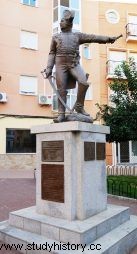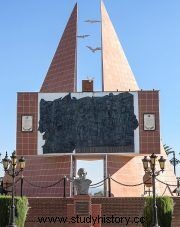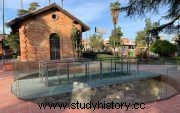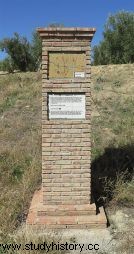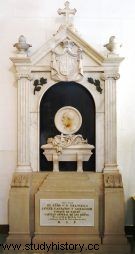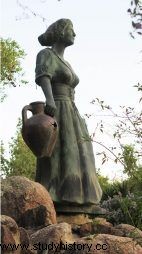The battlefield of Bailén It has an approximate extension of 2 kilometers from east to west and 3 kilometers from north to south. The western zone, where the French army was deployed, has been the least affected by urban transformations. In addition, in 2002, the Junta de Andalucía included the Huerta de Don Lázaro or del Sordo in its General Catalog of Andalusian Historical Heritage as a “Historic Site of the Battle of Bailén”. This supposes the protection and conservation of a space of 5200 m 2 . Its importance in the battle is due to the fact that it was the only water supply point for the French and was hotly contested throughout a day characterized by high temperatures.
The battlefield of Bailén today
Currently, the Huerta de Don Lázaro It is the most significant territorial element and constitutes an emblematic enclave where, for Bailén, the memory of such an event survives. On the other hand, in 2018, the Bailén City Council installed several landmarks on the battlefield, such as the Haza Walona or the Huerta de Arteaga, with a brief explanation of what happened in that place. The city also has numerous places of memory:monuments, commemorative streets and the Museum of the Battle of Bailén, inaugurated on the occasion of the Bicentennial. Among the first, it is worth mentioning the mausoleum of General Castaños (1963), the monument of the Battle of Bailén (1987) and the statue of General Reding (2008).
Bailén is one of the few battles in the history of Spain that the public easily identifies. Its name is immediately recognized as the victory of the Spanish Army over the French troops in 1808. And it is because of the impact and meaning it had. Above all, it was the first major defeat for Napoleon's army, which suffered thousands of casualties in one day:2,600 dead and 17,000 prisoners. For this reason, that July 19, 1808 appeared in patriotic propaganda as an example for all of Europe that it was possible to stop the Corso . The following month, the Junta de Sevilla created a medal of distinction that, as a military decoration, was awarded to the officers and soldiers who participated in the battle. In 1809, the Central Board granted Bailén the title of "Very Noble and Loyal"; In addition, the municipal corporation and the neighbors received a medal with the motto "To Valor and Loyalty." In the following decades, "Las Fiestas de Bailén" were formalized, celebrated between July 17 and 22. A set of civic-military acts that commemorate the victory and where the Virgin of Zocueca, patron saint of the town, takes center stage, bearing, since 1825, the Great Crowned Cross of San Fernando. A gift from General Castaños. A century later, Alfonso XIII granted the Virgin the rank of captain general, "for the crucial help" that she was credited with in battle.
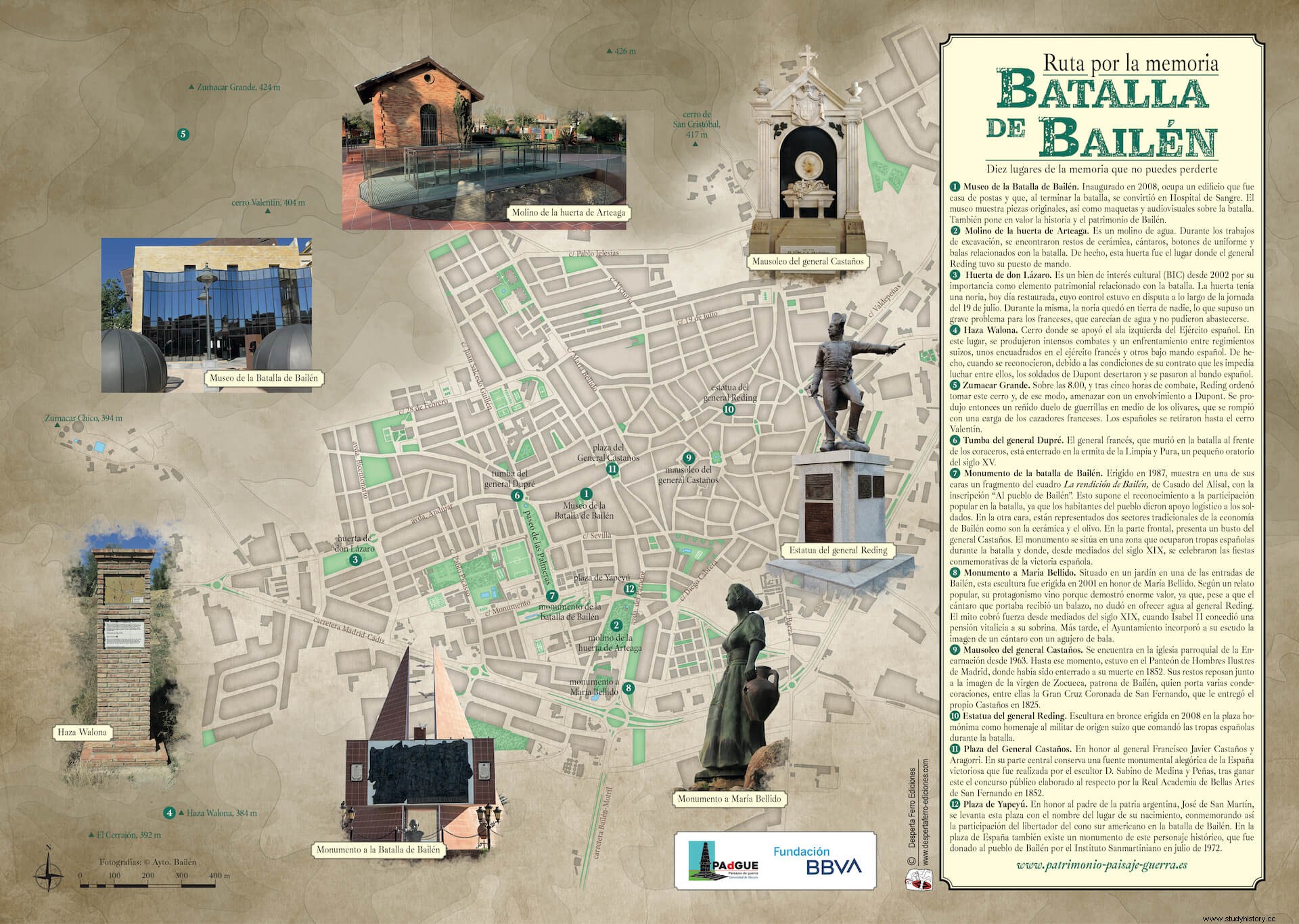
Bailén, place of memory
Throughout the 19th century, the Battle of Bailén became a place of memory and a milestone in the construction of Spanish nationalism. Its iconographic representation through the canvas The Surrender of Bailén (1864), by José Casado del Alisal, is well known and has been reproduced on numerous magazine covers and in history manuals.
In Bailén, the street map has 37 streets with names referring to characters or places from the War of Independence. Thus, we find a good number of soldiers from the Spanish Army:Castaños , Reding, Carrero, Coupigny, Venegas, Murillo and San Martin. The participation of San Martín in the battle is also reflected in Plaza Yapeyú, birthplace of the independence leader. The French have Dupont and Dupré streets; the latter, moreover, is buried in the hermitage of La Limpia y Pura, in the center of the city.
Among the local characters, María Bellido she is the most prominent, although her figure is confused between reality and myth. She is credited with the role of water carrier during the battle, especially when she gave General Reding a drink, for her courage and serenity despite the fact that the pitcher she was carrying was hit by a bullet. After Isabel II's visit to Bailén in 1862, the heroine's niece received a life pension for having kept the bullet, which was then given to the queen. And, in 1927, the city's coat of arms officially incorporated the image of a pitcher with a hole. In addition, Bellido has a street and there is another symbolically linked to it:Calle Spetses, a Greek city twinned with the Spanish, because Laskarina Bubulina, heroine of independence, died there in 1825. Finally, in 2001, the City Council erected a sculptural monument in honor of María Bellido in some gardens.
- Statue of General Reding (2008). Francisco Javier Galan. Reading Square, Bailen. © PAdGUE Project
- Monument to the Battle of Bailén. © PAdGUE Project
- Huerta de Arteaga Mill. © City Hall of Bailén
- Haza Walona, Bailén battlefield. © PAdGUE Project
- Mausoleum of General Castaños. © PAdGUE Project
- Monument to María Bellido (2001). Francisco Fernandez de los Rios. Bailén.© PAdGUE Project
Other streets and spaces in the Andalusian city fix certain events, historical constructions and commemorations in the collective memory. Thus, for example, we see:Avenida Bicentenario, Calle de la Independencia, Plaza Dos de Mayo, Calle Cádiz, Calle Arapiles, or the streets July 19 and Capitulation of Bailén. The street map also remembers three authors who fixed their attention on Bailén:the writer Pérez Galdós, the painter Casado del Alisal and the historian De Haro Malpesa.
Finally, since 2005 and during the first week of October, historical recreations are carried out with the participation of hundreds of reenactors who wear uniforms from different units of the Spanish and French armies. Bailén has two associations of this type that, together with the City Council, promote the celebration of these tourist-cultural days:The Napoleonic Historical-Cultural Association "Volunteers of the battle of Bailén" and the Historical Recreation Cultural Association "Bailen for the Independence". During the recreations, some catering establishments prepare "Battle of Bailén" menus, among which dishes we can find:the "Pipirrana María Bellido", the "Duque de Bailén red marinated deer loin" or the "Torrija stuffed on imperial delicacy". This event receives more and more public and contributes to highlighting the heritage related to the battle of Bailén.
The research project Landscapes of war , directed by the University of Alicante with funding from the BBVA Foundation, has produced this report and the video that you can find at the beginning of this article.
References
- Acosta Ramírez, Francisco:“Women in the Andalusian campaign:María Bellido and the battle of Bailén”, in Irene Castells Oliván, M. Gloria Espigado Tocino and María Cruz Romeo Mateo (coord.), Heroines and Patriots:Women of 1808 . Madrid:Chair, 2009, pp. 57-80.
- Bailen City Council:Discover the heritage:http://www.ayto-bailen.com/index.php/descubre-el-patrimonio
- Domínguez Rodríguez, Rafael:«The monuments to the Battle of Bailén in the Spanish press in the 19th century. Between the local and the national”, Locvber , 1, 2017, p. 97-111.
- Domínguez Rodríguez, Rafael:“The monuments to the Battle of Bailén in the Spanish press in the 20th century. Between the local and the national”, Locvber , 2, 2017, p. 51-71.
- García Cárcel, Ricardo:“El mito de Bailén”, in Francisco Acosta Ramírez and Marta Ruiz Jiménez (coord.):Baylen 1808-2008:proceedings of the International Congress «Baylen 1808-2008»:Bailén, its impact on the new Europe of the 19th century and its future projection . Jaén:University of Jaén, 2009, pp. 301-322.
- Haro Malpesa, Jesús de:«The impact of the battle of Bailén in France. French historiography”, in VV.AA. The Battle of Bailén. Minutes of the First Conference on the Battle of Bailén and contemporary Spain . Jaén:University of Jaén, 1999, pp. 155-201.
- Haro Malpesa, Jesús de:“The campaign of Andalusia and the Battle of Bailén in Spanish history and historiography of the 19th and 20th centuries”, in Bailén y the war against Napoleon in Andalusia:proceedings of the Second Conference on the Battle of Bailén and contemporary Spain» . Jaén:University of Jaén, 2001, pp. 61-130.
- López Pérez, Manuel:«María Bellido:a woman for a battle. Myth and truth in the heroine of Bailén», in Francisco Acosta (coord.), Conflict and civil society:women in war. Proceedings of the Fourth Conference on the Battle of Bailén and contemporary Spain . Jaén:University of Jaén, 2003, pp. 21-83.
- Moreno Alonso, Manuel:The Battle of Bailén. The rise of a nation . Madrid, Flint, 2008, pp. 404-409.
- Museum of the Battle of Bailén:http://museobatalladebailen.es/index.php/es
- Research project «Landscapes of war»:Report «The battlefield of Bailén», at https://www.patrimonio-paisaje-guerra.es/, University of Alicante-BBVA Foundation, 2020, ISAN 0000-0005-8FFC-0000-N-0000-0000-5.
- Sañudo Bayón, Juan José; Stampa Piñeiro, Leopoldo and Arcón Domínguez, José Luis:Field battles of 1808. First campaign of 1808 . Valencia, SIMTAC, 2008.

